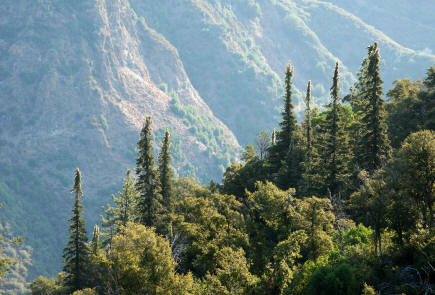|
SANTA LUCIA
FIR
Abies
bracteata

A small cluster of Santa Lucia firs in
the Ventana Wilderness. Photo by
Pete Veilleux
Scattered in
the Santa Lucia Mountains of the Los Padres National Forest is
the rarest and most unusual of all species of fir, the Santa
Lucia fir (also known as the bristlecone fir). Found only in the
mountains whose name it bears, the Santa Lucia fir is restricted
to the upper watersheds of the Carmel, Little Sur, Big Sur,
Arroyo Seco, San Antonio and Nacimiento Rivers, and in many
smaller watersheds of the Big Sur region — always within 13
miles of the coast. The southern-most documented populations are
located near Hearst's Castle, in northwestern San Luis Obispo
County.
 Considered
the "rebels" of the firs, the Santa Lucia fir has a number of
unique characteristics that makes it unmistakable (and almost
strange). Needles that are usually short, thick, and soft on
firs grow to be two inches long on the Santa Lucia fir and are
thin and dagger-tipped (easily piercing your skin if you grab at
a branch too carelessly). Its cones are found only in the very
top of the tree’s crown, which grow unique long papery bristles,
giving them a look like a roosting hedgehog! They also have very
narrow and sharply pointed spire-like crowns, which resemble the
crowns of fir and spruce species of subalpine and arctic
regions. Considered
the "rebels" of the firs, the Santa Lucia fir has a number of
unique characteristics that makes it unmistakable (and almost
strange). Needles that are usually short, thick, and soft on
firs grow to be two inches long on the Santa Lucia fir and are
thin and dagger-tipped (easily piercing your skin if you grab at
a branch too carelessly). Its cones are found only in the very
top of the tree’s crown, which grow unique long papery bristles,
giving them a look like a roosting hedgehog! They also have very
narrow and sharply pointed spire-like crowns, which resemble the
crowns of fir and spruce species of subalpine and arctic
regions.
The tree can
grow as high as 100 feet, and is often found alongside coast
redwoods or various species of oaks. It usually grows singly or
in small groups. Amongst fir species of North America, the Santa
Lucia fir has the smallest range and is the most rare.
While population trends on national forest lands are poorly
known, the Santa Lucia fir is not considered to currently be at
risk of extinction.
History
The Esselen
and Salinan Indians (in whose traditional territories the
species occurs) certainly had their own names for this species,
but the padres at Mission San Antonio de Padua were reported to
have known the trees as Incensio, for they used its resin in the
manufacturing of incense. It wasn’t “officially recorded” until
the spring of 1831 when the first botanist, David Douglas,
collected a specimen of the species on a ridge west of Mission
San Antonio. They are now widely distributed in botanical and
private gardens, but for reasons unknown, garden specimens
frequently do not exhibit the narrow spire-like crowns typical
of the trees of the Santa Lucia Mountains.
Threats
The greatest
potential danger to the Santa Lucia fir is probably a
catastrophic fire event (which due to its very narrow range
could render the species near-extinct in a worst case scenario).
Also, Santa Lucia Firs have thin barked trunks and densely
foliage which extends almost to the base of the tree, so they
are readily consumed by forest fires. A positive factor is that
these special firs are almost entirely restricted to two
habitats (deep and moist canyon bottoms and dry rocky slopes and
ledges) that are both generally fire safe.
Another
detrimental factor affecting this species is the destruction of
seeds caused by parasitism by a small wasp called a chalcid.
Fortunately the effects that the chalcids have on the
reproduction of the Santa Lucia Fir is cyclical, and even in an
effected area the trees can produce abundant crops of viable
seeds.
Possibly
because of its rarity and preference for steep topography, the
Santa Lucia fir has escaped the threat of commercial logging
over time. It is estimated that today more than 90% of the
population occurs within the Ventana Wilderness of the Monterey
District of the Los Padres National Forest, and thus they should
continue to be protected from any future exploitation.
A recently recognized threat is
the invasion of nonnative species into the understory. French
broom is particularly invasive and difficult to eradicate once
established. French broom directly competes with seedlings of
Santa Lucia fir.
Protection Efforts
 In
addition to the protection afforded to the Santa Lucia Fir
through the Ventana Wilderness designation, in 2005 the Los
Padres National Forest also established the Ventana Cones
Research Natural Area in the heart of the Ventana Wilderness.
This 2,200-acre RNA was established to specifically protect the
Santa Lucia fir and its associated rock-outcrop vegetation. In
the coming years, the Forest Service will prepare a management
plan for the area to ensure the continued protection of Santa
Lucia fir. The fir is also classified as "Sensitive" by the
Forest Service, giving it special management consideration.
Distribution map of Santa Lucia Fir In
addition to the protection afforded to the Santa Lucia Fir
through the Ventana Wilderness designation, in 2005 the Los
Padres National Forest also established the Ventana Cones
Research Natural Area in the heart of the Ventana Wilderness.
This 2,200-acre RNA was established to specifically protect the
Santa Lucia fir and its associated rock-outcrop vegetation. In
the coming years, the Forest Service will prepare a management
plan for the area to ensure the continued protection of Santa
Lucia fir. The fir is also classified as "Sensitive" by the
Forest Service, giving it special management consideration.
Distribution map of Santa Lucia Fir
|